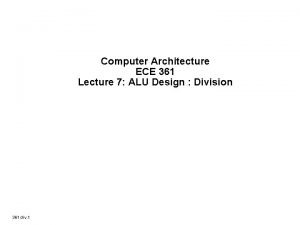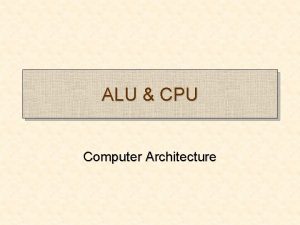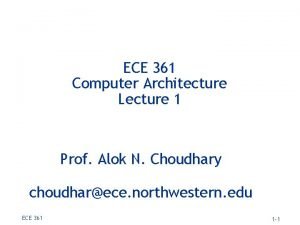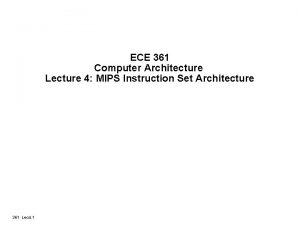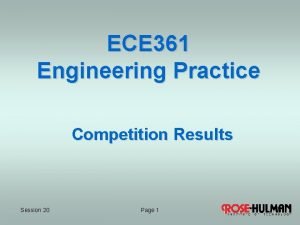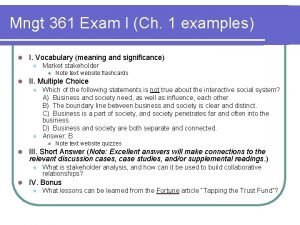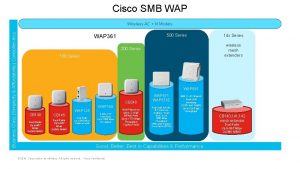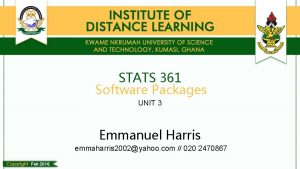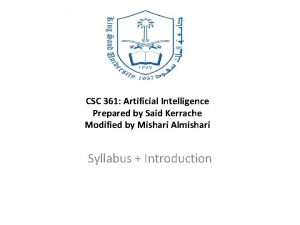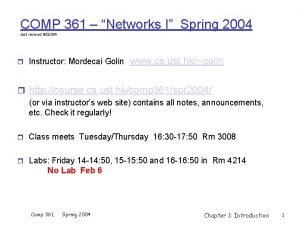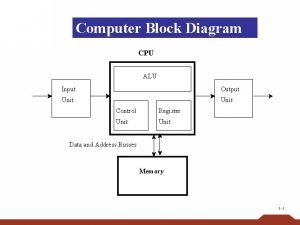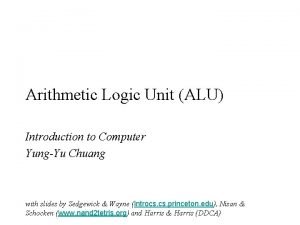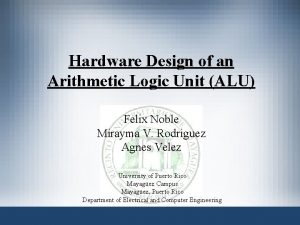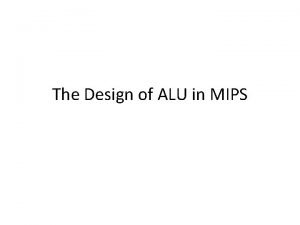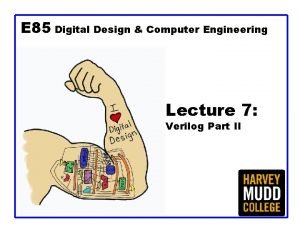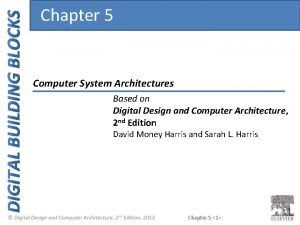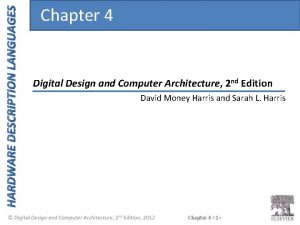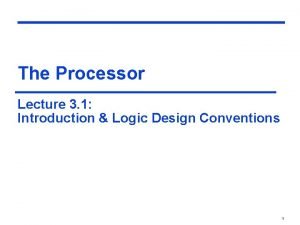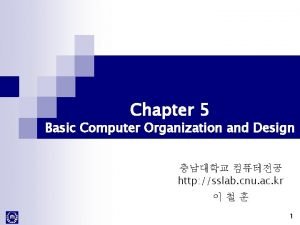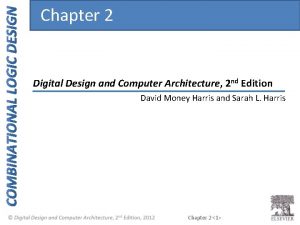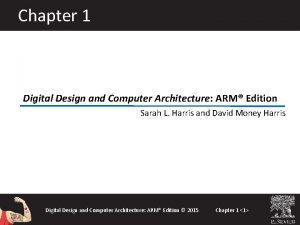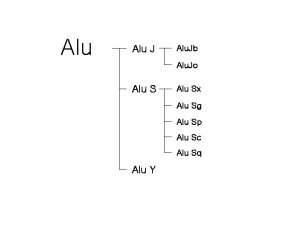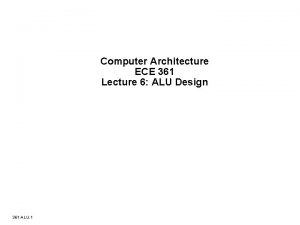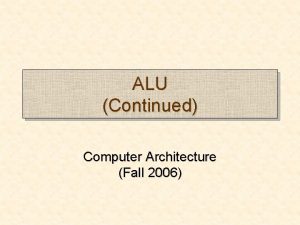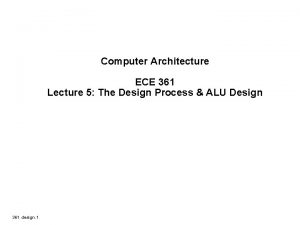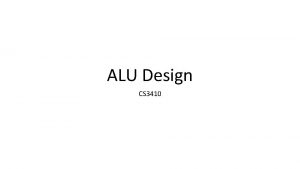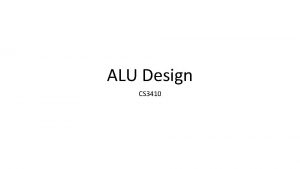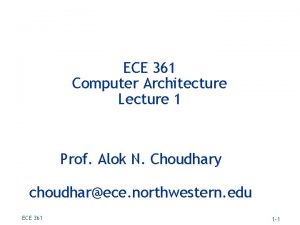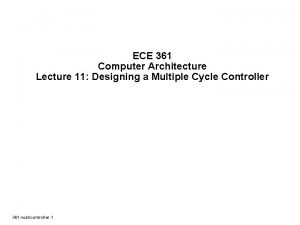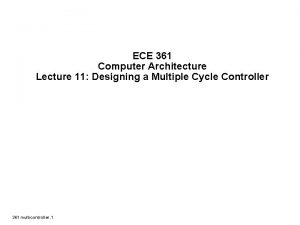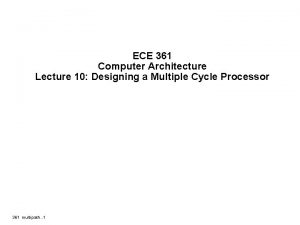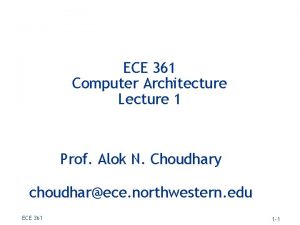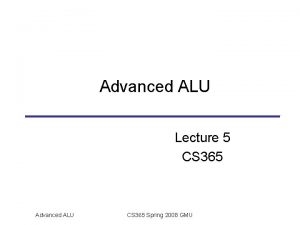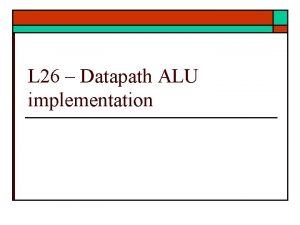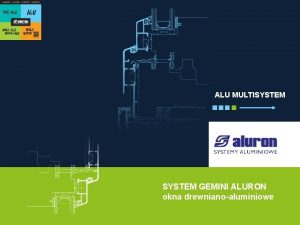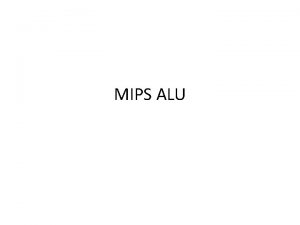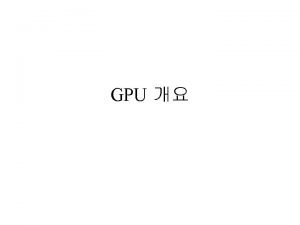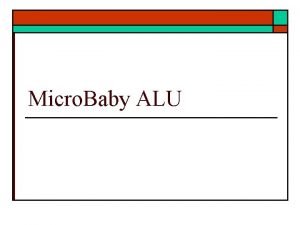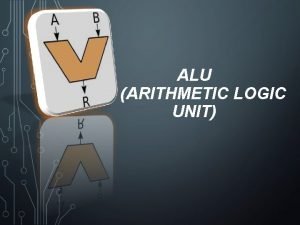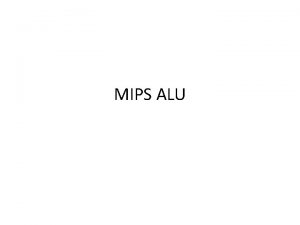Computer Architecture ECE 361 Lecture 6 ALU Design

































- Slides: 33

Computer Architecture ECE 361 Lecture 6: ALU Design 361 ALU. 1

Review: ALU Design ° Bit slice plus extra on the two ends ° Overflow means number too large for the representation ° Carry look ahead and other adder tricks A 32 B 32 signed arith and cin xor co a 0 a 31 b 31 ALU 0 co cin s 0 ALU 31 co cin s 31 Ovflw 361 ALU. 2 b 0 S 32 4 M C/L to produce select, comp, c-in

Review: Elements of the Design Process ° Divide and Conquer (e. g. , ALU) • Formulate a solution in terms of simpler components. • Design each of the components (subproblems) ° Generate and Test (e. g. , ALU) • Given a collection of building blocks, look for ways of putting them together that meets requirement ° Successive Refinement (e. g. , multiplier, divider) • Solve "most" of the problem (i. e. , ignore some constraints or special cases), examine and correct shortcomings. ° Formulate High Level Alternatives (e. g. , shifter) • Articulate many strategies to "keep in mind" while pursuing any one approach. ° Work on the Things you Know How to Do • The unknown will become “obvious” as you make progress. 361 ALU. 3

Outline of Today’s Lecture ° Deriving the ALU from the Instruction Set ° Multiply 361 ALU. 4

MIPS arithmetic instructions ° ° ° ° Instruction Example Meaning Comments add $1, $2, $3 $1 = $2 + $3 3 operands; exception possible subtract sub $1, $2, $3 $1 = $2 – $3 3 operands; exception possible add immediate addi $1, $2, 100 $1 = $2 + 100 + constant; exception possible add unsigned addu $1, $2, $3 $1 = $2 + $3 3 operands; no exceptions subtract unsigned subu $1, $2, $3 $1 = $2 – $3 3 operands; no exceptions add imm. unsign. addiu $1, $2, 100 $1 = $2 + 100 + constant; no exceptions multiply mult $2, $3 Hi, Lo = $2 x $3 64 -bit signed product multiply unsigned multu$2, $3 Hi, Lo = $2 x $3 64 -bit unsigned product divide div $2, $3 Lo = $2 ÷ $3, Lo = quotient, Hi = remainder Hi = $2 mod $3 divide unsigned divu $2, $3 Lo = $2 ÷ $3, Unsigned quotient & remainder Hi = $2 mod $3 Move from Hi mfhi $1 $1 = Hi Used to get copy of Hi Move from Lo mflo $1 $1 = Lo Used to get copy of Lo 361 ALU. 5

MIPS logical instructions Instruction Example Meaning Comment and $1, $2, $3 $1 = $2 & $3 3 reg. operands; Logical AND or or $1, $2, $3 $1 = $2 | $3 3 reg. operands; Logical OR xor $1, $2, $3 $1 = $2 Å $3 3 reg. operands; Logical XOR nor $1, $2, $3 $1 = ~($2 |$3) 3 reg. operands; Logical NOR and immediate andi $1, $2, 10 $1 = $2 & 10 Logical AND reg, constant or immediate ori $1, $2, 10 $1 = $2 | 10 Logical OR reg, constant xor immediate xori $1, $2, 10 $1 = ~$2 &~10 Logical XOR reg, constant shift left logical sll $1, $2, 10 $1 = $2 << 10 Shift left by constant shift right logical srl $1, $2, 10 $1 = $2 >> 10 Shift right by constant shift right arithm. sra $1, $2, 10 $1 = $2 >> 10 Shift right (sign extend) shift left logical $1 = $2 << $3 Shift left by variable shift right logical srlv $1, $2, $3 $1 = $2 >> $3 Shift right by variable shift right arithm. srav $1, $2, $3 $1 = $2 >> $3 Shift right arith. by variable 361 ALU. 6 sllv $1, $2, $3

Additional MIPS ALU requirements ° Xor, Nor, Xor. I => Logical XOR, logical NOR or use 2 steps: (A OR B) XOR 1111. . 1111 ° Sll, Sra => Need left shift, right shift arithmetic by 0 to 31 bits ° Mult, Mult. U, Div. U => Need 32 bit multiply and divide, signed and unsigned 361 ALU. 7

Add XOR to ALU ° Expand Multiplexor Carry. In A Mux B 1 -bit Full Adder Carry. Out 361 ALU. 8 Result

Shifters Three different kinds: logical value shifted in is always "0" msb lsb "0" arithmetic on right shifts, sign extend msb lsb "0" rotating shifted out bits are wrapped around (not in MIPS) left msb lsb right msb lsb Note: these are single bit shifts. A given instruction might request 0 to 32 bits to be shifted! 361 ALU. 9

Administrative Matters 361 ALU. 10

MULTIPLY (unsigned) ° Paper and pencil example (unsigned): Multiplicand Multiplier Product 1000 1001 1000 0000 1000 01001000 ° m bits x n bits = m+n bit product ° Binary makes it easy: • 0 => place 0 ( 0 x multiplicand) • 1 => place a copy ( 1 x multiplicand) ° 4 versions of multiply hardware & algorithm: • successive refinement 361 ALU. 11

Unsigned Combinational Multiplier 0 A 3 A 3 P 7 P 6 A 2 A 1 P 5 A 2 A 1 0 A 0 B 1 A 0 B 2 A 0 P 4 B 3 P 2 P 1 P 0 ° Stage i accumulates A * 2 i if Bi == 1 ° Q: How much hardware for 32 bit multiplier? Critical path? 361 ALU. 12

How does it work? 0 0 0 A 3 A 3 P 7 P 6 A 2 P 5 A 2 A 1 P 4 0 A 3 A 2 A 1 0 A 0 B 1 A 0 B 2 A 0 P 3 B 0 B 3 P 2 P 1 P 0 ° at each stage shift A left ( x 2) ° use next bit of B to determine whether to add in shifted multiplicand ° accumulate 2 n bit partial product at each stage 361 ALU. 13

Unisigned shift add multiplier (version 1) ° 64 bit Multiplicand reg, 64 bit ALU, 64 bit Product reg, 32 bit multiplier reg Shift Left Multiplicand 64 bits Multiplier 64 -bit ALU Product 32 bits Write 64 bits Multiplier = datapath + control 361 ALU. 14 Control Shift Right

Multiply Algorithm Version 1 Multiplier 0 = 1 Start Multiplier 0 = 0 1. Test Multiplier 0 1 a. Add multiplicand to product & place the result in Product register ° Product Multiplier Multiplicand 0000 0011 2. Shift the Multiplicand register left 1 bit. ° 0000 0010 0001 0000 0100 ° 0000 0110 0000 1000 ° 0000 0110 361 ALU. 15 3. Shift the Multiplier register right 1 bit. 32 nd repetition? No: < 32 repetitions Yes: 32 repetitions Done

Observations on Multiply Version 1 ° 1 clock per cycle => 100 clocks per multiply • Ratio of multiply to add 5: 1 to 100: 1 ° 1/2 bits in multiplicand always 0 => 64 bit adder is wasted ° 0’s inserted in left of multiplicand as shifted => least significant bits of product never changed once formed ° Instead of shifting multiplicand to left, shift product to right? 361 ALU. 16

MULTIPLY HARDWARE Version 2 ° 32 bit Multiplicand reg, 32 bit ALU, 64 bit Product reg, 32 bit Multiplier reg Multiplicand 32 bits Multiplier 32 -bit ALU 32 bits Shift Right Product 64 bits 361 ALU. 17 Control Write Shift Right

Multiply Algorithm Version 2 Multiplier 0011 0010 Multiplicand 0000 Start Product Multiplier 0 = 1 1. Test Multiplier 0 = 0 1 a. Add multiplicand to the left half of product & place the result in the left half of Product register ° Product 0000 Multiplier Multiplicand 0011 0010 2. Shift the Product register right 1 bit. 3. Shift the Multiplier register right 1 bit. 32 nd repetition? 361 ALU. 18 No: < 32 repetitions Yes: 32 repetitions Done

What’s going on? 0 0 A 3 A 2 A 1 A 0 B 0 B 1 A 3 A 2 A 1 A 0 P 7 P 6 P 5 B 2 B 3 P 4 P 3 P 2 ° Multiplicand stay’s still and product moves right 361 ALU. 19 P 1 P 0

Observations on Multiply Version 2 ° Product register wastes space that exactly matches size of multiplier => combine Multiplier register and Product register 361 ALU. 21

MULTIPLY HARDWARE Version 3 ° 32 bit Multiplicand reg, 32 bit ALU, 64 bit Product reg, (0 bit Multiplier reg) Multiplicand 32 bits 32 -bit ALU Shift Right Product (Multiplier) 64 bits 361 ALU. 22 Control Write

Multiply Algorithm Version 3 Multiplicand 0010 Product 0000 0011 Product 0 = 1 Start 1. Test Product 0 = 0 1 a. Add multiplicand to the left half of product & place the result in the left half of Product register 2. Shift the Product register right 1 bit. 32 nd repetition? 361 ALU. 23 No: < 32 repetitions Yes: 32 repetitions Done

Observations on Multiply Version 3 ° 2 steps per bit because Multiplier & Product combined ° MIPS registers Hi and Lo are left and right half of Product ° Gives us MIPS instruction Mult. U ° How can you make it faster? ° What about signed multiplication? • easiest solution is to make both positive & remember whether to complement product when done (leave out the sign bit, run for 31 steps) • apply definition of 2’s complement - need to sign extend partial products and subtract at the end • Booth’s Algorithm is elegant way to multiply signed numbers using same hardware as before and save cycles - can handle multiple bits at a time 361 ALU. 24

Motivation for Booth’s Algorithm ° Example 2 x 6 = 0010 x 0110: x + + 0010 0110 0000 0010 0100 00001100 shift (0 in multiplier) add (1 in multiplier) shift (0 in multiplier) ° ALU with add or subtract gets same result in more than one way: 6 = – 2 + 8 , or 0110 = – 0010+ 1000 ° Replace a string of 1 s in multiplier with an initial subtract when we first see a one and then later add for the bit after the last one. For example x + – + + 361 ALU. 25 0010 0110 0000 0010 00001100 shift (0 in multiplier) sub (first 1 in multiplier) shift (middle of string of 1 s) add (prior step had last 1)

Booth’s Algorithm Insight Current Bit to the Right Explanation Example 1 0 Beginning of a run of 1 s 0001111000 1 1 Middle of a run of 1 s 0001111000 0 1 End of a run of 1 s 0001111000 0 0 Middle of a run of 0 s 0001111000 Originally for Speed since shift faster than add for his machine Replace a string of 1 s in multiplier with an initial subtract when we first see a one and then later add for the bit after the last one 361 ALU. 26

Booths Example (2 x 7) Operation Multiplicand Product next? 0. initial value 0010 0000 0111 0 10 > sub 1 a. P = P m 1110 0111 0 + 1110 shift P (sign ext) 1 b. 0010 1111 0011 1 11 > nop, shift 2. 0010 1111 1001 1 11 > nop, shift 3. 0010 1111 1100 1 01 > add 4 a. 0010 + 0010 0001 1100 1 shift 0000 1110 0 done 4 b. 361 ALU. 27 0010

Booths Example (2 x 3) Operation Multiplicand 0. initial value 0010 1 a. P = P m 1110 1101 0 Product next? 0000 1101 0 + 1110 shift P (sign ext) 1 b. 0010 + 0010 1111 0110 1 01 > add 2 a. 0001 0110 1 shift P 2 b. + 0010 1110 0000 1011 0 10 > sub 3 a. 0010 1110 1011 0 shift 3 b. 4 a 0010 1111 0101 1 shift 4 b. 0010 1111 1010 1 361 ALU. 28 done 11 > nop 10 > sub

Booth’s Algorithm 1. Depending on the current and previous bits, do one of the following: 00: a. Middle of a string of 0 s, so no arithmetic operations. 01: b. End of a string of 1 s, so add the multiplicand to the left half of the product. 10: c. Beginning of a string of 1 s, so subtract the multiplicand from the left half of the product. 11: d. Middle of a string of 1 s, so no arithmetic operation. 2. As in the previous algorithm, shift the Product register right (arith) 1 bit. 361 ALU. 29

MIPS logical instructions ° ° ° ° Instruction Example Meaning and $1, $2, $3 or or $1, $2, $3 xor $1, $2, $3 nor $1, $2, $3 and immediate andi $1, $2, 10 or immediate ori $1, $2, 10 xor immediate xori $1, $2, 10 shift left logical sll $1, $2, 10 shift right logical srl $1, $2, 10 shift right arithm. sra $1, $2, 10 shift left logical sllv $1, $2, $3 shift right logical srlv $1, $2, $3 shift right arithm. srav $1, $2, $3 361 ALU. 30 Comment $1 = $2 & $3 $1 = $2 | $3 $1 = $2 $3 $1 = ~($2 |$3) $1 = $2 & 10 $1 = $2 | 10 $1 = ~$2 &~10 $1 = $2 << 10 $1 = $2 >> 10 $1 = $2 << $3 $1 = $2 >> $3 3 reg. operands; Logical AND 3 reg. operands; Logical OR 3 reg. operands; Logical XOR 3 reg. operands; Logical NOR Logical AND reg, constant Logical OR reg, constant Logical XOR reg, constant Shift left by constant Shift right (sign extend) Shift left by variable Shift right arith. by variable

Shifters Two kinds: logical value shifted in is always "0" msb lsb "0" arithmetic on right shifts, sign extend msb lsb "0" Note: these are single bit shifts. A given instruction might request 0 to 32 bits to be shifted! 361 ALU. 31

Combinational Shifter from MUXes Basic Building Block sel A B 1 0 D 8 -bit right shifter A 7 A 6 A 5 A 4 A 2 A 1 S 2 S 1 S 0 A 0 1 0 1 0 1 0 1 0 1 0 1 0 R 7 R 6 R 5 R 4 ° What comes in the MSBs? ° How many levels for 32 bit shifter? ° What if we use 4 1 Muxes ? 361 ALU. 32 A 3 R 2 R 1 R 0

General Shift Right Scheme using 16 bit example S 0 (0, 1) S 1 (0, 2) S 2 (0, 4) S 3 (0, 8) If added Right to left connections could support Rotate (not in MIPS but found in ISAs) 361 ALU. 33

Summary ° Instruction Set drives the ALU design ° Multiply: successive refinement to see final design • 32 bit Adder, 64 bit shift register, 32 bit Multiplicand Register • Booth’s algorithm to handle signed multiplies ° There algorithms that calculate many bits of multiply per cycle (see exercises 4. 36 to 4. 39 ) ° What’s Missing from MIPS is Divide & Floating Point Arithmetic 361 ALU. 34
 64 bit alu
64 bit alu Control unit design
Control unit design Design of alu in computer architecture
Design of alu in computer architecture Computer architecture
Computer architecture Ece 361
Ece 361 Ece 361
Ece 361 Design of basic computer
Design of basic computer Computer architecture lecture notes
Computer architecture lecture notes Isa vs microarchitecture
Isa vs microarchitecture Computer-aided drug design lecture notes
Computer-aided drug design lecture notes Washington rx services
Washington rx services Mngt 361 exam 1
Mngt 361 exam 1 Wap 361
Wap 361 Stats 361
Stats 361 Hymn 361
Hymn 361 Wind energy source
Wind energy source Csc 361
Csc 361 Comp 361
Comp 361 01:640:244 lecture notes - lecture 15: plat, idah, farad
01:640:244 lecture notes - lecture 15: plat, idah, farad And operation
And operation Hack alu
Hack alu Bus design in computer architecture
Bus design in computer architecture Alu hardware or software
Alu hardware or software Set on less than alu
Set on less than alu Difference between computer architecture and organisation
Difference between computer architecture and organisation Memory system design in computer architecture
Memory system design in computer architecture Digital design and computer architecture
Digital design and computer architecture Digital design and computer architecture
Digital design and computer architecture Digital design and computer architecture
Digital design and computer architecture Digital design and computer architecture
Digital design and computer architecture Processor logic design
Processor logic design Flowchart for memory reference instructions
Flowchart for memory reference instructions Bubble pushing example
Bubble pushing example Digital design and computer architecture arm edition
Digital design and computer architecture arm edition
